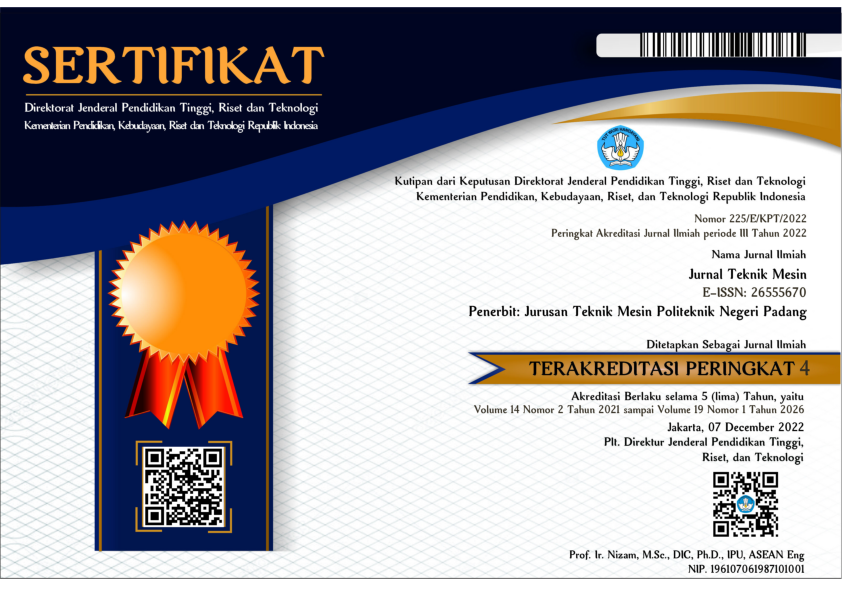Metode Peningkatan Ketahanan Retak Resin Polyester Terhadap Penambahan Serat Sekam Padi
Abstract
Polymer materials have been widely developed as alternative materials to replace metal materials due to various advantages such as having low density and an easy manufacturing process. Still, polymers have many disadvantages, including not having high mechanical strength, easy to crack when hit by impact. One of the materials studied is an unsaturated polyester polymer widely used for composite matrices in vehicle structural components, aircraft and ship bodies, and vehicle components. One of the studied fibers is rice husk particle fiber. The study of cracks is essential because it causes the material to no longer be able to support the load according to the previous plan and causes failure to occur more quickly. One way to overcome material failure due to cracks in the composite material is to prevent crack propagation by adding reinforcing material. In this study, a composite material was made using rice husk fiber to increase the crack resistance of the polyester composite matrix. From the results of crack testing, there is a tendency to increase the percentage of rice husks by 5%, 10%, 15%, and 20%. The value expected to be obtained for determining the crack resistance of the material is the value of the stress intensity factor (K1). The most significant K1 value was obtained at a 15% rice husk percentage variable of 1,558 MPa.m0.5. This price could increase the value of the pure polyester stress intensity factor K1 by 0.667 MPa.m0.5, indicating an increase of 233.58%.
References
Hiremath, N., Young, S., Ghossein, H., Penumadu, D., Vaidya, U., and Theodore, M., 2020. Low cost textile-grade carbon-fiber epoxy composites for automotive and wind energy applications. Composites Part B: Engineering, 198.
Davallo, M., Pasdar, H., and Mohseni, M., 2010. Mechanical properties of unsaturated polyester resin. International Journal of Chemical Technology Research, 2 (4), pp. 2113–2117.
Abral, H., Fajrul, R., and Mahardika, M., 2019. Improving impact, tensile and thermal properties of thermoset unsaturated polyester via mixing with thermoset vinyl ester and methyl merhacrylate. Polymer Testing, 81.
Frómeta, D., Parareda, S., Lara, A., Molas, A., Casellas, D., Jonsen, P., and Calvo, J., 2020. Identification of fracture toughness parameters to understand the fracture resistance of advanced high strength sheet steels. Engineering Fracture Mechanics, 229.
Adnan, N., Abral, H., Dahlan, H., and Satria, E., 2022. Identification of Mechanical Strength for Mixture of Thermoset Polyester with Thermoset Vinyl Ester due to Bending Load. JMPM (Jurnal Material dan Proses Manufaktur), 6 (1), pp. 19–25.
Adnand, N., Mutya, R., Ridwan, F., Abral, H., Dahlan, H., and Satria, E., 2021. Pengaruh Variasi Persentase Campuran Polymer Polyester dan Vinyl Ester Terhadap Kekuatan Tegangan Lentur. Metal: Jurnal Sistem Mekanik dan Termal, 5 (2), pp. 126-131.
Naik, P. K., Londe, N. V., Yogesha, B., Naik, L. L., and Pradeep, K. V., 2018. Mode I Fracture Characterization of Banana Fibre Reinforced Polymer Composite. IOP Conference Series Materials Science and Engineering, 376 (1).
Ardhyananta, H., Puspadewa, F. D., Wicaksono, S. T., Widyastuti, Wibisono, A. T., Kurniawan, B. A., Ismail, H., and Salsac, A. V. , 2017. Mechanical and Thermal Properties of Unsaturated Polyester/Vinyl Ester Blends Cured at Room Temperature. IOP Conference Series Materials Science Engineering, 202 (1).
Nusyirwan, Abral, H., Hakim, M., and Vadia, R., 2019. The potential of rising husk fiber/native sago starch reinforced biocomposite to automotive component. IOP Conference Series Materials Science Engineering, 602 (1).
Agung, G. F., Sy, M. R. H., and Mardina, P., 2013. Ekstraksi silika dari abu sekam padi dengan pelarut KOH. Konversi, 2 (1), pp. 28-31.
Seyhan, A. T., Tanoǧlu, M., and Schulte, K., 2009. Tensile mechanical behavior and fracture toughness of MWCNT and DWCNT modified vinyl-ester/polyester hybrid nanocomposites produced by 3-roll milling. Materials Science Engineering: A, 523, (1–2), pp. 85–92.
Yang, Z., Peng, H., Wang, W., and Liu, T., 2010. Crystallization behavior of poly(ε-caprolactone)/layered double hydroxide nanocomposites. Journal of Applied Polymer Sciences, 116 (5), pp. 2658–2667.
Budiman, A. dan Sugiman, S., 2016. Karakteristik Sifat Mekanik Komposit Serat Bambu Resin Polyester Tak Jenuh Dengan Filler Partikel Sekam. Dinamika Teknik Mesin, 6 (1), pp. 76–82.
Abral, H., Fajrul, R., Mahardika, M., Handayani, D., Sugiarti, E., Muslimin, A. N., and Rosanti, S. D., 2021. Nanovoids in fracture surface of unsaturated polyester/vinyl ester blends resulting from disruption of the cross-linking of the polymer chain networks. IOP Conference Series Materials Science Engineering, 1062 (1).
Jeyanthi, S. and Rani, J. J., 2012. Improving mechanical properties by KENAF natural long fiber reinforced composite for automotive structures. Jornal of Applied Science Engineering, 15 (3), pp. 275–280.
Meng, Q. and Wang, T., 2019. An improved crack-bridging model for rigid particle-polymer composites. Engineering Fracture Mechanics, 211, pp. 291–302.
Dhakal, H. N. and Ismail, S. O., 2019. Unsaturated polyester resins: Blends, interpenetrating polymer networks, composites, and nanocomposites. Unsaturated Polyester Resins, pp. 181-198.
Liu, K., He, S., Qian, Y., An, Q., Stein, A., and Macosko, C. W., 2019. Nanoparticles in Glass Fiber-Reinforced Polyester Composites: Comparing Toughening Effects of Modified Graphene Oxide and Core-Shell Rubber. Polymer Composites, 40 (S2), pp. E1512–E1524.
Nusyirwan, 2015. Metode Pengering Gabah Aliran Massa Kontinu Dengan Wadah Pengering Horizontal dan Pengaduk Putar. Mechanical, 6 (2), pp. 82–88.
Ali, N. A. B. U. and Karim, K. J. B. A., 2015. A Review of the Properties and Applications of Poly (Methyl Methacrylate) (PMMA). Polymer Review, 55 (4), pp. 678–705.
Kalia, S. and Vashistha, S., 2012. Surface Modification of Sisal Fibers 9 (Agave Sisalana) Using Bacterial Cellulase and Methyl Methacrylate. Journal of Polymers and the Environment, 20 (1), pp. 142–151.
ASTM, 1996. Standard Test Methods for Plane-Strain Fracture Toughness and Strain Energy Release Rate of Plastic Materials. Annual Book of ASTM Standards, 99, pp. 1–9.













